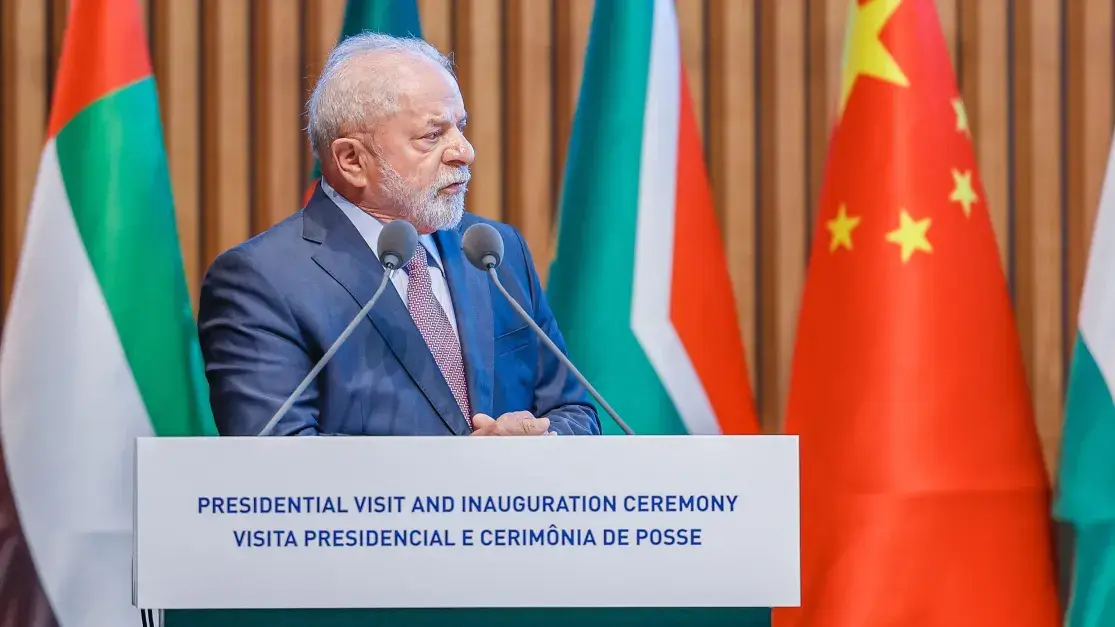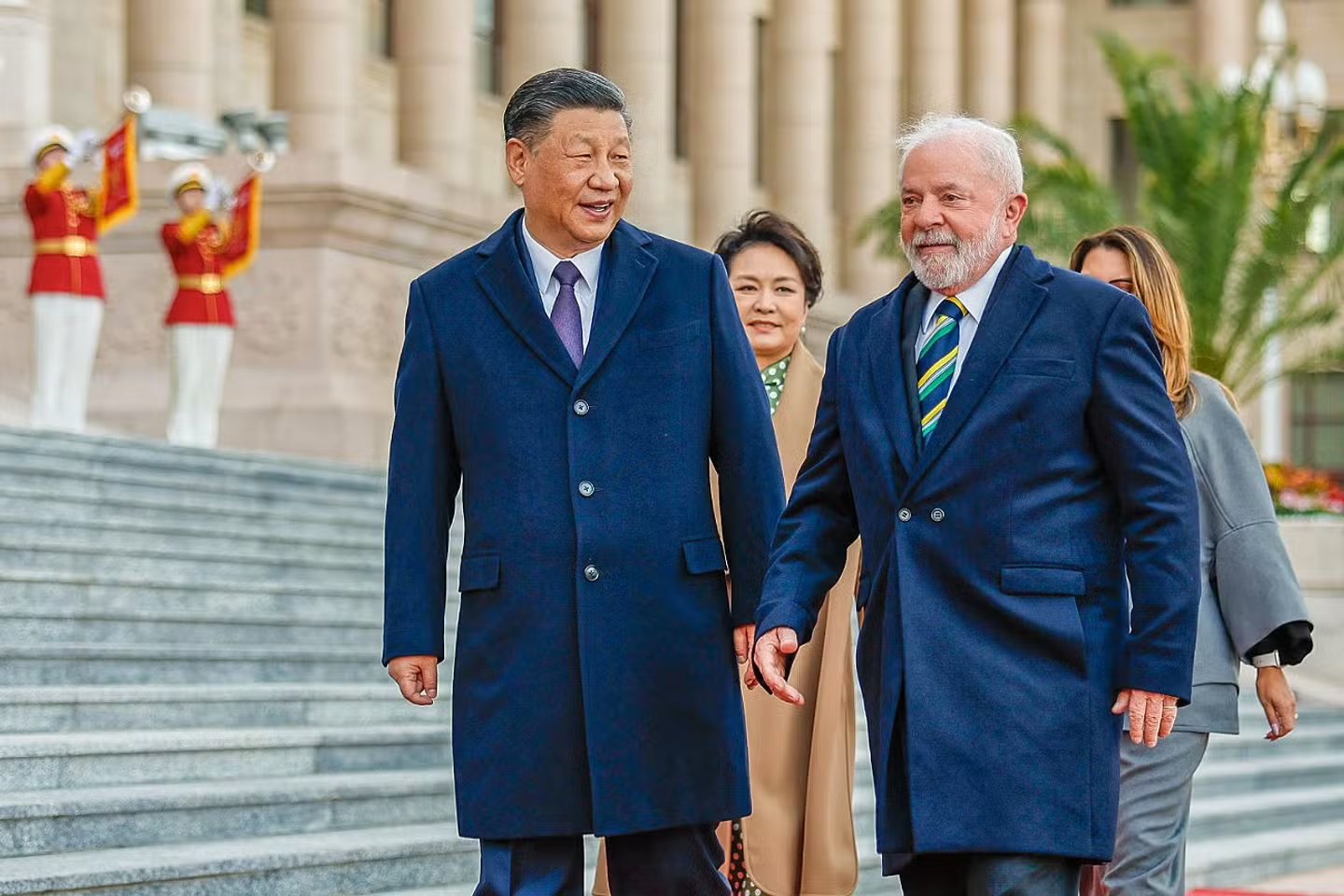Lula sets the tone in China

Business not as usual
eyesonbrasil
Amsterdam, 16 april 2023– He brought an entourage. Brazilian President Luiz Inácio Lula da Silva traveled to China this week along with dozens of political representatives and more than two hundred business leaders for a visit that focused on improving trade and economic ties between the largest countries in Asia and South America.
His meeting with Chinese leader Xi Jinping on Friday in Beijing followed February’s meeting with US President Joe Biden in the White House, as Lula is using the early months of his term to set a new tone abroad. Our experts are here to answer the burning questions about what this trip tells us about the two Global South heavyweights.
1. What does Lula come away with from Beijing?
In addition to the fifteen agreements signed between Brazil and China, Lula also leaves Beijing with a path toward greater cooperation even beyond trade. Given that China is Brazil’s number one trading partner, this visit was an important seal for Lula, wrapping up his first hundred days in office having visited Brazil’s top three economic partners: Argentina, the United States, and now China.
Recent comments by Brazilian Finance Minister Fernando Haddad reflect Brazil’s intent to deepen economic relations with both China and the United States. “Brazil has the size to make bilateral agreements,” Haddad told journalists during the China trip.
—Valentina Sader is an associate director and Brazil lead at the Atlantic Council’s Adrienne Arsht Latin America Center.
2. During the trip, Lula called for BRICS countries to trade in their own currencies and end the dollar’s trade dominance. How real is this threat?
In calling for an end to the dollar’s dominance in world trade during his China visit, Lula was singing to a choir whose theme song is renminbi (RMB) internationalization.
His advocacy of a “BRICS currency” to replace the dollar in settling trade transactions among leading emerging-market countries (Brazil, Russia, India, China, and South Africa make up the informal BRICS group) likely won’t come to much—at least in the foreseeable future.
Nonetheless, it does underline the opportunities for Beijing to increase the international use of the Chinese currency. As Brazil’s trade with China hit a record $ 140 billion last year, the RMB emerged as the country’s second-largest reserve currency (representing 5.37 percent of foreign-exchange holdings).
That’s an indication of a trend of increasing RMB-real transactions, which likely will continue in the future as the two countries have signed several agreements aimed at expanding trade. However, Brazilian imports and exports continue to be settled overwhelmingly in dollars, and the US currency still occupies over three-quarters of Brazilian reserves.
At the end of March, a Brazilian bank (controlled by a Chinese parent) became the first financial institution in Latin America to join China’s Cross-Border Interbank Payment System, which settles trade deals in the Chinese currency. But most Brazilian companies continue to use the dollar-based SWIFT messaging system.
Even as the RMB’s global share of trade transactions doubles to 4.5 percent in 2022, the dollar remained the currency of choice in 84 percent of all trade deals worldwide.
— Jeremy Mark is a nonresident senior fellow with the GeoEconomics Center. He previously worked for the IMF and the Asian Wall Street Journal.
3. What did China gain from this visit?
From what we have seen thus far, Lula and Xi gained crucial “wins” from their bilateral meeting. The two signed fifteen bilateral in everything from agriculture to technology, demonstrating further development of the China-Brazil comprehensive strategic partnership.
Lula even visited a Huawei technology development center and received a presentation about how 5G can revolutionize telemedicine and education; this suggests Lula’s willingness to accelerate China’s 5G expansion in Brazil, despite US efforts to slow China’s 5 G advance in the region due to espionage concerns.
Both leaders also successfully projected themselves as champions of the Global South, professing their desire to “balance world geopolitics,” advocating for their countries as mediators in Ukraine, and upholding the BRICS mechanism as a counterweight to the US-dominated international system. However, Lula’s most inflammatory statement that BRICS countries ditch the US dollar and trade in their own currencies was likely bluster, especially given the fact that the US dollar still accounts for 60 percent of global central bank reserves.
— Leland Lazarus is a nonresident fellow at the Global China Hub and associate director for national security at Florida International University’s Jack Gordon Institute of Public Policy. He formerly served as special assistant and speechwriter to the commander of US Southern Command and as a US State Department foreign service officer in China and the Caribbean.
4. What do Lula’s visits to both Washington and Beijing reveal about his foreign policy approach?
Differently from the trip to Washington in February, Lula’s visit to Beijing had a more clear and concrete purpose.
The trip to Washington was aimed at reestablishing relations and discussing cooperation on common challenges, such as democracy and climate. The visit to Beijing had an important business component.
Both were significant in consolidating Lula’s foreign-policy goals.
Brazil will continue its traditional non-alignment, non-interventionist approach to foreign policy, seeking to maintain close diplomatic relations with strategic partners, which include both the United States and China. At the same time, Lula will continue to push for the rethinking of the global order to reflect current times, carving out that relevance for Brazil.
A few examples include Lula’s interest in leading peace conversations between Russia and Ukraine, hosting the Group of Twenty (G20) summit in 2024, questioning the reliance on the dollar, proposing changes to the United Nations Security Council, and sending a special foreign policy advisor to Venezuela for meetings with the Maduro regime and its opposition.
The question that remains is whether or not Lula is picking the right battles—and if he will have the support, domestically and internationally, to be successful.
—Valentina Sader
5. How can the Lula visit be seen within the context of Xi’s renewed outreach to the Global South?
Lula’s visit to China and meeting with Xi reflects Lula’s desire to again—as in his previous times in office—be at the center of the global stage.
And it is a visit that is squarely within China’s priorities to deepen ties with Brazil as part of its quest for greater leadership in the Global South.
China is Brazil’s number one trade partner. And this visit is a clear signal that those economic ties will only deepen in the years to come.
What cannot be missed is the difference in pomp and delegation size between the China visit and Lula’s trip to Washington two months earlier. Whereas the US visit was a short, two-day stop without a business contingent, the China trip is twice as long with a large delegation of businesspeople looking for new commercial opportunities now that China has reopened after its COVID-19 lockdowns.
It’s also reflective of Lula’s inauguration: China sent then Vice President Wang Qishan—a close ally of Xi—to lead its delegation, while the US delegation was led by Interior Secretary Deb Haaland.
— Jason Marczak is the senior director of the Adrienne Arsht Latin America Center.
eyesonbrasil




![Friends Again [ ?? ] Lula-e-Biden-na-Casa-Branca-848×477](https://eyesonsuriname.com/storage/2023/02/Lula-e-Biden-na-Casa-Branca-848x477-1-150x150.jpg)




